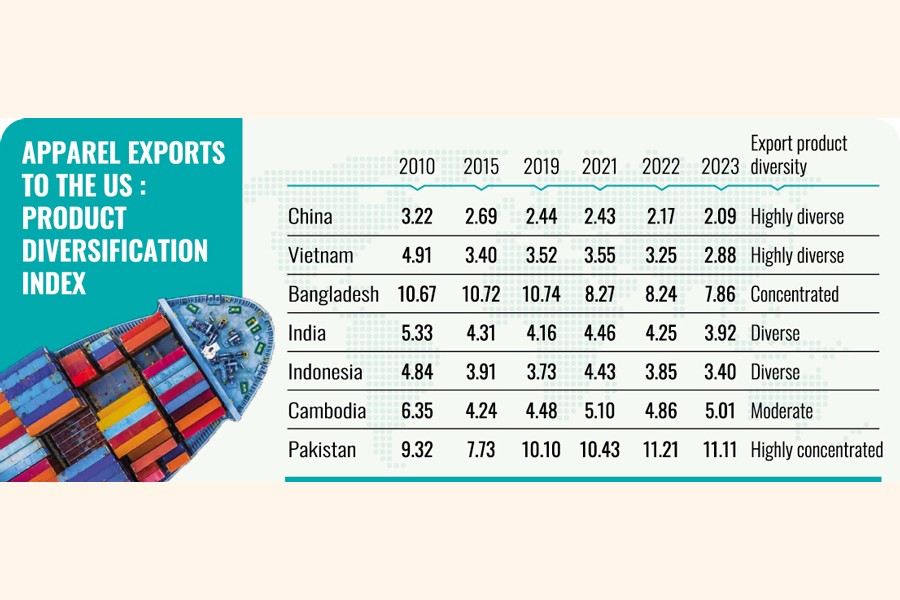
Bangladesh remains mired in basic items
Shows analysis as China, Vietnam forge ahead with apparel variety
MONIRA MUNNI | Friday, 16 February 2024

Diversify or die: it's an adage that sounds like an alarm bell ringing loudly and for a long duration, but it still fails to awaken the local apparel industry in the face of the rapidly changing global market.
The fact is again evident in an analysis of US apparel sourcing in 2023.
The analysis classifies Bangladesh's apparel export diversity to the US as "concentrated", while key competitors China, India, Vietnam, Indonesia and Cambodia receive better grades: ranging from "moderate" to "highly diverse".
According to government data, over 80 per cent of Bangladesh's apparel export earnings in the last fiscal year came from shipping basic items like tee shirts, trousers, shirts, sweaters and underwear to the Western market.
Local apparel manufacturers acknowledge that diversification does not happen overnight: it requires investment, infrastructure support, consistent energy and raw material supplies and, of course, time.
The analysis, conducted by Dr Sheng Lu, an associate professor and director of Graduate Studies in the Department of Fashion and Apparel Studies at the University of Delaware, shows that despite a decline in its US market share, China remains highly competitive due to the variety of products it offers.
The analysis shows that China offers a far wider selection of clothing styles. It adds that "US fashion companies continued reducing their China exposure as much as possible, but China will remain a key player in the game".
In contrast, Bangladesh, though experiencing market share growth, is still primarily favoured by US buyers for high-volume basic items, reflecting the country's heavy dependence on a few readymade garment categories.
Meanwhile, Vietnam has been capitalising on the "China shift" more effectively than Bangladesh, with a more diverse product range.
Citing the export product diversification index, calculated based on trade data, the analysis reveals that "US fashion companies were utilising Vietnam as a sourcing base for outerwear, underwear and swimwear; India for dresses; and Bangladesh for large-volume basic knitwear items".
The Index categorises China and Vietnam as offering "highly diverse" apparel items, while India and Indonesia offer "diverse", Cambodia "moderate" and Bangladesh remains "concentrated" on basic items.
According to data from the Export Promotion Bureau (EPB), over 80 per cent of Bangladesh's total $46.99 billion readymade garment export earnings in the last fiscal year came from just five items: t-shirts, trousers, shirts, sweaters and underwear.
Faruque Hassan, president of the Bangladesh Garment Manufacturers and Exporters Association (BGMEA), acknowledged that Bangladesh still produces large volumes of basic garments, but argued that value-added production has also begun.
Citing US data, he noted that the unit price of local garments increased last year compared to 2022, which is a positive sign.
He further pointed to rising imports of non-cotton materials like polyester and man-made fibres in recent months, suggesting an increase in the production of value-added and non-cotton-based garments in Bangladesh.
He, however, called for a smooth supply chain, including consistent gas supplies and streamlined customs processes for value-added items, to achieve the target of $100 billion in export earnings by 2030.
While talking to The Financial Express, Fazlul Haque, former president of the Bangladesh Knitwear Manufacturers and Exporters Association (BKMEA), said diversification requires investment and expertise, which are still at a low level in Bangladesh.
Bangladesh has huge potential for diversified goods as it already has established foreign markets as a key player -- the second largest exporter in the global market, he said.
Though diversification is taking place in the country, it is not at the required level compared to the industry's size, he noted.
Mahmud Hasan Khan, managing director of Rising Group, provided historical context, noting that all garment-producing countries start with basic items before transitioning to more diverse offerings.
He acknowledged that Bangladesh currently focuses on large-volume basics, but insisted on the fact that diversification cannot happen overnight, despite ongoing efforts.
He underlined the challenges of infrastructure limitations, including unreliable gas and electricity supply and the current dollar crisis.
Mr Khan compared Bangladesh to competitors like China and Vietnam, noting that China's strong backward linkages and Vietnam's access to Chinese support contribute to their diverse offerings. He cited data showing China's US market share declining from 37.32 per cent in 2013 to 20.96 per cent in 2023, while Vietnam's share grew to 18.21 per cent, capitalising on the shift through value-added products.
India, Cambodia, and Indonesia held market shares of 5.74 per cent, 4.27 per cent and 5.38 per cent, respectively, in 2023.
In contrast, Bangladesh's share increased from 6.20 per cent in 2013 to 9.37 per cent in 2023, showcasing the potential for further growth.